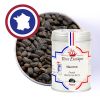French chaste tree berry
4.450000




Details
How to use this berry from the marshes
Grind these chaste tree berry seeds at the very last minute to release their full floral aromas. Our recipe ideas for this chaste tree berry:• Sea bream with chaste tree berry: sprinkle a couple of twists of your pepper mill filled with chaste tree berry on your fish before serving (check out our recipe below);
• Mashed potato and chaste tree berry: sprinkle 3 twists of your pepper mill filled with chaste tree berry on your mash before serving;
• Plum jam with chaste tree berry: add 1 teaspoon of ground chaste tree berry to your saucepan of jam before potting;
• Pickled gherkins: add 4 to 5 chaste tree berry seeds in your jars of pickled gherkins;
• Choucroute with chaste tree berry: add 6 chaste tree berries to your cabbage.
Sea bream with chaste tree berry
The aromas of chaste tree berry
The chaste tree berry’s subtle scent is dominated by notes of summer truffle and fruit. Its floral aromas are surprising developing into woody notes with a slight fennel-like bitter taste.The botanical properties of chaste tree berry
The entire plant is edible
The botanical name of chaste tree berry is Smyrnium olusatrum Linné which is part of the Apiaceae family. The name Smyrnium comes from Smyrn, the former name of Izmir in Turkey. Indeed, the chaste tree berry is initially from the Middle East and the Mediterranean. It was introduced to France by the Romans, then later by the crusaders on their return from the crusades. It was the Cistercian monks of Chateliers Abbey who brought it to Ile de Ré. This plant is widely used and is entirely edible, its root looks like a large radish black, its stalk can be used to replace salsify, its leaf looks like parsley, the flower buds can be eaten like capers and its seeds like pepper. Nowadays it thrives in the salty marshes where it fights with wild mustard for space to grow. It is harvested by hand by a few salt farmers on Île de Ré.Chaste tree berry has been used since Ancient times
Chaste tree berry was imported from Asia Minor by the Romans to the Mediterranean and then to the Atlantic coast. This plant became widespread in France with the return of the crusaders. Chaste tree became very popular in the Middle Ages and was considered a very useful plant as it is entirely edible.More Information
| Price/kg | 116,66 |
|---|---|
| Allergen | Absence |
| Native country | FRANCE |
| Genus and botanical species | Smyrnium olusatrum |
| Ingredients | alexanders |
| Contenance | 60g |
| TRACES EVENTUELLES D'ALLERGÈNES | céleri, sésame, moutarde, fruits à coques. |
 Français
Français 